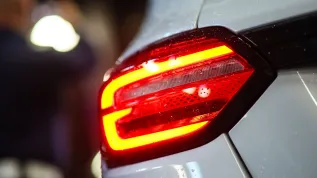
Very light, made entirely in one piece bridge has been created by engineers from at Gdańsk University of Technology. Weighing just over three tons crossing can carry 18 tons. On May 13 it passed a symbolic load test: approx. 100 people went on it.
The bridge is made of a composite material, including foam from used PET. The structure is created in one piece, and making a prototype took one week (industrial production will take approx. two days). The bridge is 14 meters long and weighs only 3.2 tons. It will be used, among others, as a footbridge for pedestrians and cyclists.
The structure was created within the project Fobridge, headed by Prof. Jacek Chróścielewski from the Department of Structural Mechanics, Faculty of Civil and Environmental Engineering, Gdańsk University of Technology.
Two weeks ago the prototype located on the campus passed a symbolic load test. The organizers hoped that 180 people would gather on the crossing, but eventually approx. 100 people turned up. "The purpose of the load test with the participation of the people was primarily to promote our project. Of course, nobody would allow people to enter an untested structure. We have already conducted successful stress tests with concrete slabs weighing nearly 18 tons" - told PAP Prof. Chróścielewski.
The scientist explained that the uniqueness of the Fobridge project lies in the fact that bridge (due to using a reusable mould) can be mass produced - on an industrial scale, and can be made quickly. "The beam can be made in mere two days, and approx. one week passes from the date of order to delivery of finished bridge" - said Prof. Chróścielewski.
He added that another advantage of the bridge is the use in the production of readily available and inexpensive materials, which in addition allow you to make a durable, but lightweight object, making it easy to transport. Chróścielewski explained that a concrete bridge the size of the prototype made in the Fobridge project would weigh approx. 30 tons.
According to Prof. Chróścielewski, another advantage of the structure made by his team is that the bridge is easy to maintain and install, non-flammable, and resistant to atmospheric agents.
Composite materials have been used for the production of the bridge. Production is carried out by the so-called infusion. Carious composites, including fabric of glass fibres and foam, which forms the core (made from recycled PET) are arranged in sequence inside the prepared mould. "We also place technology layers to ensure the supply of resin and all this is covered with a sealed bag. Inside the mould we produce a vacuum, which means that the resin is sucked in by other composites and - after removing the bag, we heat the object, polymerization follows and we obtain the finished unit" - said Prof. Chróścielewski.
He added that beam, which was created under the project Fobridge, was made mainly with a view of using it as a part of a footbridge for pedestrians and cyclists over main roads. "But of course, this structure can be used wherever it is found useful" - said Prof. Chróścielewski and added that he hoped to find a company that would undertake the production of the bridge.
In addition to a team of scientists from the Gdańsk University of Technology, employees of the Military University of Technology in Warsaw and the company Roma are involved in the Fobridge project.
Work on the project started two years ago and will continue until the end of 2015. Scientists and entrepreneurs have received a grant from the National Centre for Research and Development.
PAP - Science and Scholarship in Poland
aks/ gma/ mrt/
tr. RL













